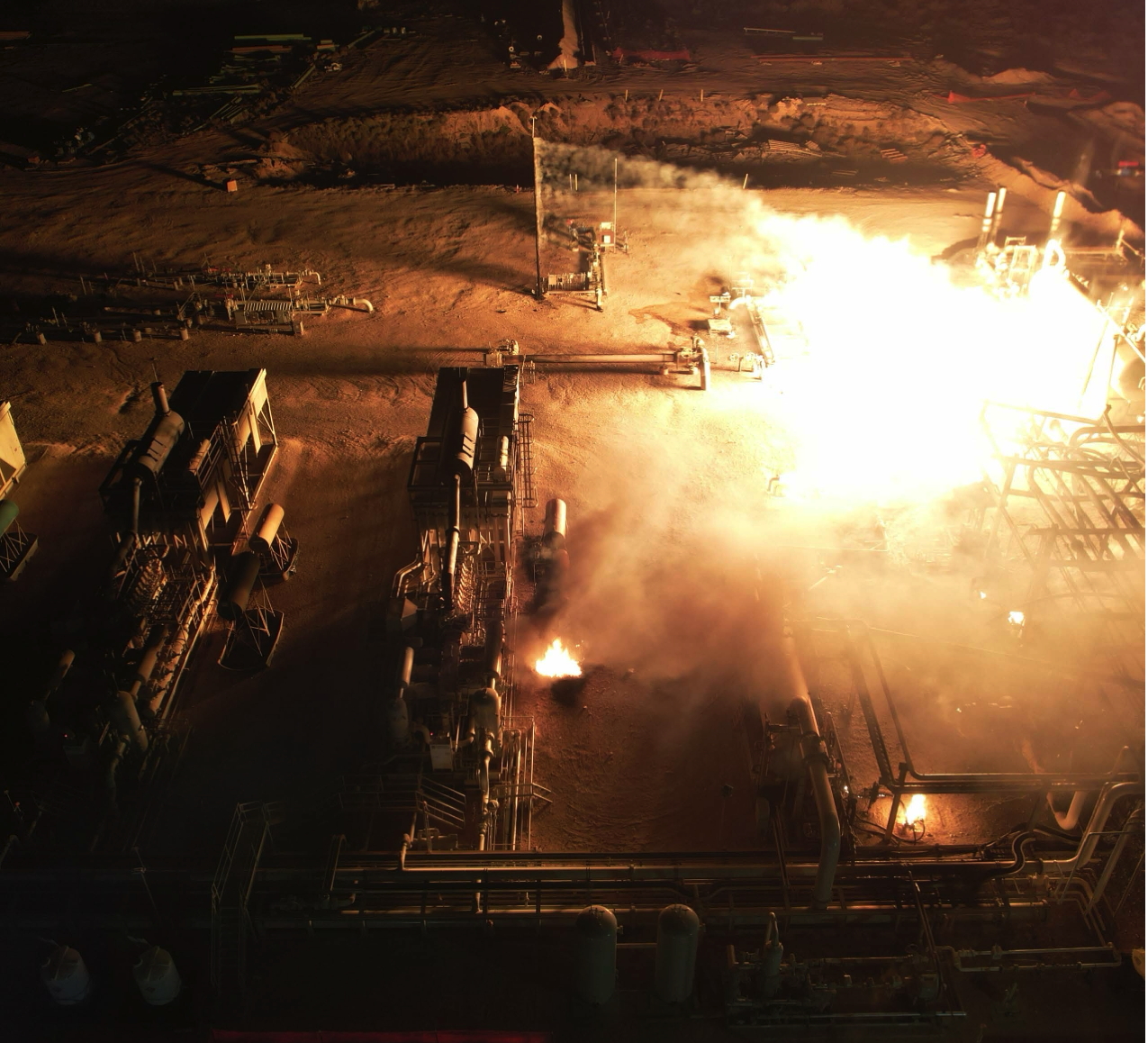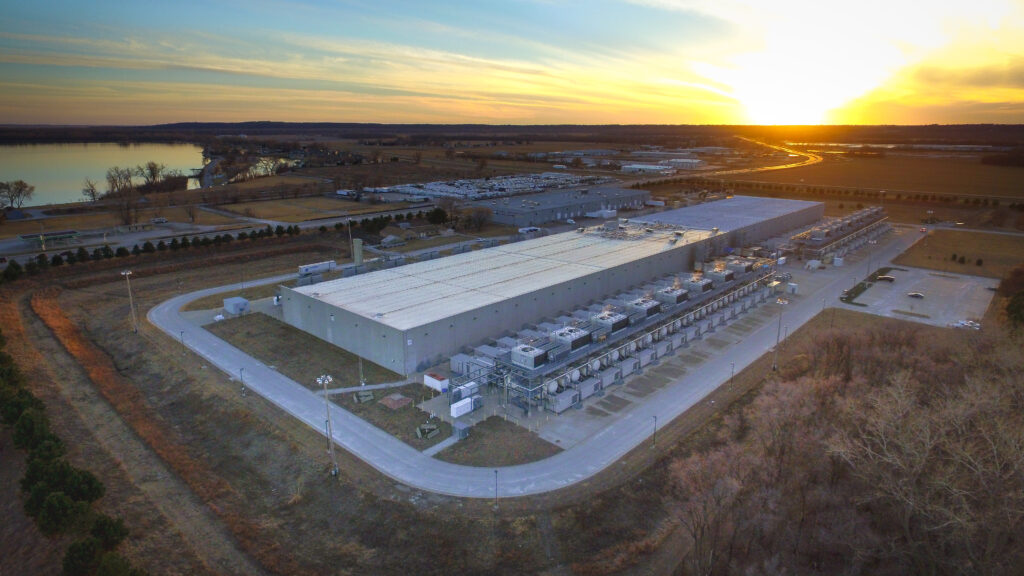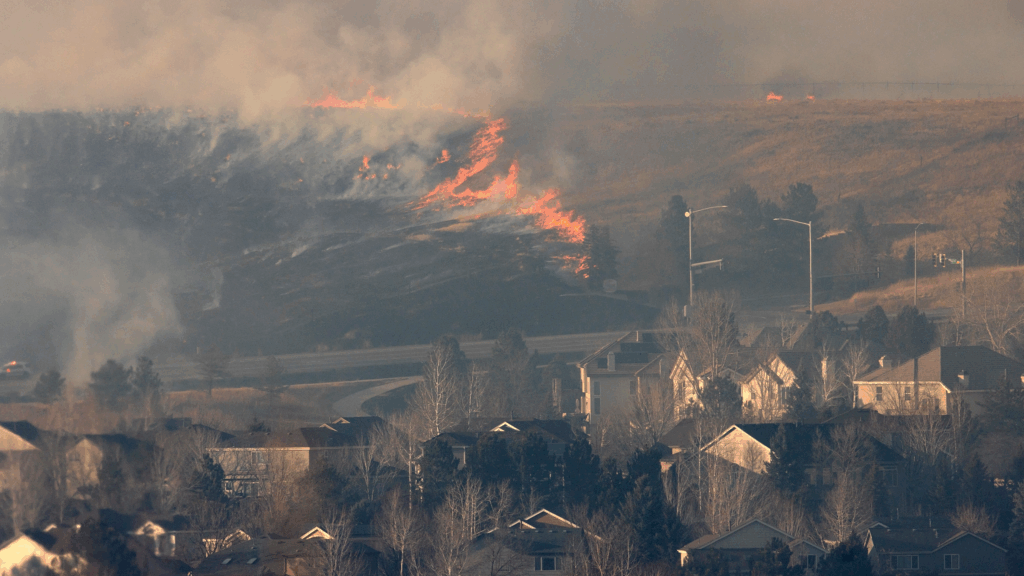The trouble began at Piñon Midstream’s Dark Horse Treating Plant in Jal, New Mexico, on November 25, 2023, with an unexpected loud “pop” in the early afternoon, the company would later tell state regulators. A poisonous mix of flammable gasses hissed out from a pipeline feeding into the plant.
Within a minute, a worker radioed in to the plant’s control room that a dense cloud of vapor had enveloped part of the plant. Within two minutes, Dark Horse was ablaze in what the company would later call an “intense and sustained fire.” Within 15 minutes, more pipes ripped open, and a towering fireball tore through the plant.
Black plumes of smoke streamed over the desert and the Permian Basin shale below. An onlooker swore in Spanish as the fireball expanded across the sky, one anonymous video posted on Instagram shows. A second burst of flames erupted after dark as the fire burned on.
Subscribe to our newsletter
Stay up to date with DeSmog news and alerts
It was two days before the first Piñon workers, wearing firefighter-style air tanks, could approach the plant’s perimeter. It was another day before the fire was fully extinguished.
The November explosion involved some of the oilfield’s deadliest chemicals, though fortunately no injuries were reported from the fire.
The incident offers a rare window into some of the inner workings of private oil companies while also revealing how taxpayers can wind up paying enormous subsidies to carbon capture and sequestration (CCS) operations that generate far more climate-altering pollution than they prevent.
‘Sour Gas’
The fuel feeding into Dark Horse on the day of the explosion was a particularly dangerous mix, made up of methane gas, carbon dioxide (CO2), other fossil fuels, and poisonous hydrogen sulfide (H2S) gas — a toxic blend that oil companies nicknamed “sour gas” and “acid gas” due to the sulfur-like odor of hydrogen sulfide and CO2’s ability to acidify water. Dark Horse is designed to remove and dispose of the hydrogen sulfide and carbon dioxide contaminants so the rest of the gas can be sold. The company markets itself as the largest such project in New Mexico.
Dark Horse’s anchor shipper is Ameredev II, a private-equity backed driller that’s one of New Mexico’s top 25 oil producers. In June, Matador Resources (NYSE:MTDR) announced plans to acquire Ameredev II for $1.9 billion in cash. As that deal was announced, Matador management acknowledged Ameredev II’s oil production saw disruptions at the end of 2023 due to “issues” at Piñon.
State production data shows Ameredev II’s New Mexico oil production abruptly dropped by over 400,000 barrels a month in the Dark Horse fire’s aftermath — a roughly 80 percent dive.
That’s enough oil to create roughly 18 times as much climate-altering CO2 pollution as the plant would have captured if it was up and running, a review of company filings and EPA emissions data by DeSmog finds.
This summer, just seven months after the fire ripped through Dark Horse, the EPA approved a key “monitoring, reporting, and verification” plan for the project — a key step in enabling the company to claim carbon capture tax credits that could be worth over a quarter of a billion dollars.
Tax credits for Piñon would be another way that CCS incentives are being used by the oil and gas industry to fuel fossil fuel development.
The EPA’s 712-page approval makes no mention of the plant’s safety record, the fire, or its causes.
When contacted by DeSmog, Piñon Midstream declined to comment.
Oil Unleashed by Dark Horse
Sour gas is a growing curse for the oil and gas industry. “As oil and gas wells age, the H2S levels of fields where they are located may increase,” the Texas Commission on Environmental Quality (TCEQ) warns.
Some in the industry are already citing estimates that “40% of natural gas reserves are sour, with 20% being so sour they can’t be economically or technically accessed.”
Certain oil wells also produce high levels of carbon dioxide gas — not the byproduct of burning oil, but carbon dioxide that was naturally trapped below ground or injected by drillers for enhanced oil recovery. And when carbon dioxide and H2S come into contact with water, they can form corrosive acids. And there’s a lot of water involved when you drill shale oil — both the salty brines that were previously trapped underground alongside the crude and the enormous volumes of water injected underground during drilling and fracking.
Producers tend to avoid sour gas-tainted oil because when there’s enough H2S and CO2 in the mix, you need specialized equipment to remove those deadly and corrosive gasses. That adds costs and creates a single point of failure that can throw a wrench in production from multiple wells.
A small handful of Permian drillers nonetheless seem determined to tap oil deposits contaminated with particularly high levels of sour gas, reserves hazardous or expensive enough to scare off other producers.
Piñon offers a uniquely important service for those drillers. The Dark Horse plant is designed to siphon off carbon dioxide and hydrogen sulfide, turning gas considered too sour to sell into a “sweetened” fossil fuel blend that pipeline companies will accept for shipment. Dark Horse “unlocks previously challenged resource development” in Lea County, New Mexico, and in Texas’ Winkler and Loving counties, Black Bay Energy Capital, a private equity company backing Piñon, says on its website.
The company injects the removed carbon and hydrogen sulfide waste deep underground, via a pair of disposal wells — meaning that even though it doesn’t get its carbon from burning fossil fuel, what Dark Horse does is considered carbon capture and sequestration.
Piñon markets Dark Horse as part of the fight against climate-altering pollution. “Not only does our project provide a comprehensive solution for sequestering CO2 and H2S,” Piñon Midstream co-founder Steven Green said as construction of the plant kicked off in April 2021, “it also substantially reduces flaring and greenhouse gas emissions in southeast New Mexico.”
Supporters of CCS have predicted that tax credits — massively increased when the Inflation Reduction Act became law in September 2022 — will ultimately aid the fight against climate catastrophe. By creating a market for carbon, companies burning fossil fuels for power or working in “hard to abate” industries will be incentivized to capture their carbon emissions, ultimately reducing climate-altering pollution, advocates say.
So far, that’s not what’s happening. Instead, most of today’s captured carbon comes from natural gas processors like Piñon. “The majority of CO2 being captured today is not captured from power plants or industrial processes like steel or cement, which is how CCS is often marketed,” a November 2023 report from Oil Change International found. “Instead, 67% of CO2 captured today comes from gas processing plants.”
What many natural gas processing plants are doing, in other words, is essentially rebranding a long-standing way of disposing difficult oil waste into a climate solution. “It looks like acid gas injection to us,” attorneys from the law firm Alston & Bird wrote in a 2008 post about a CCS project in Michigan with plans to inject CO2 and H2S into disposal wells, “and folks have been doing that for decades.”
Turning a Blind Eye to Emissions
Dark Horse has historically tended to capture under 10,000 tons of CO2 a month, data from the company’s state and federal filings show.
But that doesn’t mean Dark Horse reduces greenhouse gas emissions. The November incident offers an unusual chance to see just how much monthly oil production Dark Horse underpins — and how much carbon pollution that oil creates.
After Dark Horse was forced offline, oil production in New Mexico from its anchor shipper, Ameredev II, plummeted.
The month before the blast, Ameredev II produced over a half million barrels of oil, state records show; the month after, it produced just over 100,000 barrels — a reduction of about 424,000 barrels a month.
That’s enough oil to produce over 182,000 metric tons of CO2 emissions, using EPA conversion formulas — over 18 times the amount of carbon Dark Horse would have captured over the same amount of time.
Carbon capture tax credit programs simply turn a blind eye to those additional — and far larger — emissions from burning those fossil fuels.
The EPA generally doesn’t track how much CO2 is created by the oil and gas a project enables or compare that to the amount of CO2 sequestered when they approve carbon capture monitoring plans, Preet Bains, a research analyst for the Environmental Integrity Project who authored a December report titled “Flaws in EPA’s Monitoring and Verification of Carbon Capture projects,” told DeSmog.
“We don’t really have that information,” she said. “It’s really just looking to see how much CO2 did you inject and do you have a way to verify that. It’s not about even preventing leaks necessarily. There’s no requirement that says, okay, if you have a leak, you have to plug it in this amount of time.”
Company IRS filings aren’t public, so researchers can’t say how much individual companies that qualify for the 45Q tax credit have actually claimed. Based on Dark Horse’s current maximum permitted capacities, at $85 per ton, Piñon’s CCS tax credits could be worth up to $255 million over the credits’ 12-year life-span.
Environmental and taxpayer watchdogs often fault subsidies for CCS projects because they enable more fossil fuel production under the guise of fighting greenhouse gas emissions – but the 2022 Inflation Reduction Act nonetheless significantly boosted subsidies under the 45Q tax credit program. Enhanced oil recovery projects, where captured carbon is used to revive the flow of oil from aging oil wells, now qualify for lower tax credits of $60 per ton, while those that dispose of carbon other ways can receive $85 per ton.
In other words, Dark Horse may qualify for significantly larger tax credits because, unlike many other carbon capture schemes, the company’s captured carbon isn’t used for enhanced oil recovery.
But federal regulators do recognize the company’s ties to the oil industry in one regard. Piñon is allowed to use cheaper disposal wells (Class II injection wells, intended for oil and gas waste, rather than Class VI wells, specifically designed for carbon sequestration). Class II wells tend to be cheaper to build than Class VI wells and take less time to permit.
“The rules are definitely a lot more lax for Class II wells,” Bains said.
It all adds up to more reasons why experts and analysts increasingly fault carbon capture tax credits for subsidizing oil and gas production in the name of fighting the climate crisis.
“If your purpose in encouraging CO2 injection is to reduce the amount of CO2 that’s going into the air,” Bains said, “it’s counter productive to subsidize an industry that’s going to produce more oil and gas and put more CO2 into the air.”
A Fire That Never Happened?
Piñon’s Dark Horse plant is located on a dirt road off a dirt road off a third dirt road, west of Jal, N.M., with the nearest “occupied structure” listed in state records almost two miles (3,000 meters) away from the site.
The majority of the roughly 1,400 people living within a 10-mile radius of Piñon’s Dark Horse facility are people of color, according to state records.
The November blaze seems to have drawn very little official response.
On the day of the fire, local police and firefighters withdrew from the scene without attempting to extinguish the fire amid fears of potentially deadly fumes. The only potential mention of the blaze in the remote oil town’s local newspaper was a single four-word entry in a police blotter: “Fire (structure) Hwy 128.”
State environmental regulators never visited the site following the fire and, as of late July, said staff had not yet reviewed key documents related to the blaze or determined if the company should face fines or violations. State records show Dark Horse has never been inspected.
Because the inferno caused over $1 million in property destruction, the federal Chemical Safety and Hazard Investigation Board (CSB) was notified — but the only publicly available documentation was a single row in a spreadsheet listing reports received by CSB. CSB failed to respond to questions about the event or to say whether federal regulators were investigating.
Dark Horse uses amine as it siphons off H2S and CO2. For decades, federal regulators have recognized the hazards involved with amine processing. “On July 23, 1984, a refinery at Romeoville, Illinois, owned and operated by the Union Oil Company of California, experienced a disastrous explosion and fire,” according to a 1986 OSHA memorandum. “An amine absorber pressure vessel rupture released large quantities of flammable gases and vapors. Seventeen lives were lost, seventeen persons were hospitalized, and more than $100 million in damages resulted.”
Piñon indicated to the New Mexico Environment Department (NMED) that the November fire had been caused by an “act of god,” NMED communications director Drew Goretzka told DeSmog. As of July, state regulators had not yet reviewed those claims.
DeSmog obtained those NMED files via a public records request. In the documents, the company pointed to a cracked piece of pipe as the suspected initial cause of the leak, but suggested the company had no way of knowing the pipe might fail.
“The identified imperfections are believed to have been present since casting by the manufacturer and are located within the metal (i.e., inside the material itself),” the company wrote.

Piñon told regulators that “the imperfections are not visible on the surface and would not have been visible or identifiable through normal maintenance, inspection, or any other planned process.”
If that’s the case, it’d be hard to say whether or not other questionable pipe might be installed at the newly built plant.
Piñon declined to comment when asked what steps the company has taken to prevent another fire.
In the months since the fire, environmental regulators have been actively involved with Dark Horse in at least one way: In February, regulators approved an air permit allowing Piñon to expand its Dark Horse operations significantly.
‘A Strong Smell of Sulfur’
Before Dark Horse was built a few years back, NMED inspectors caught Ameredev II illegally dumping unsellable sour and acid gas by burning it off or letting it escape into the air.
“Upon arrival we both noticed a strong smell of sulfur,” two New Mexico state inspectors reported, describing a December 2019 visit to an Ameredev II site. “We inspected the facility from outside the premises and a worker came out beyond the fence line to meet with us. He told us the gas plant was no longer taking their gas; therefore, they were flaring all of it.”
Sour gas has been the bane of oil producers for generations. The natural gas burned in home furnaces and gas stoves carries the sulfuric stench of mercaptan, a gas added to alert sensitive noses to the presence of the fuel. But when natural gas at the oil well carries a similar rotten-egg smell, it can mean the gas is laced with H2S.
H2S gas is dangerous stuff. After carbon monoxide, it’s the deadliest gas for U.S. workers, killing 46 people on the job from 2011 to 2017, according to a 2019 Bureau of Labor Statistics report. Hydrogen sulfide played a major role in mass extinction events hundreds of millions of years ago, a 2023 study of shale from the Bakken formation in North Dakota found. The gas is deadly enough that during World War I, the British Army tried using it for chemical warfare.
“After a while at low or more quickly at high concentrations, you can no longer smell it to warn you it’s there,” OSHA warns. “It can quickly, almost immediately, overcome unprepared workers, including rescue workers.”
New Mexico regulators were so alarmed by what they found at the Ameredev II sites that two New Mexico cabinet secretaries later took the highly unusual step of writing to the company’s private equity backer, EnCap Investments. The June 29, 2023, letter states the secretaries’ findings raised “questions about the adequacy of the resources provided to Ameredev in support of their operations and necessary institutional controls.”
The state also began investigating other company locations. “A preliminary review of Ameredev’s other facilities suggests that there may be similar problems across the company’s portfolio,” regulators wrote at the time.
That 2019 visit eventually led to the largest settlement in New Mexico Environment Department history, with Ameredev II agreeing in April to pay the state $24.5 million.
“Ameredev willfully ignored basic tenets of New Mexico’s Oil and Gas Act that have been on the books since 1935,” said then-New Mexico Energy, Minerals and Natural Resources Department secretary Sarah Cottrell Propst, “not to mention the state’s nation-leading rules to prevent climate pollution that ban routine venting and flaring.” (Cottrell Propst left the agency at the end of 2023 and now works for the American Clean Power Association, a “clean energy” trade group that has been criticized for its natural gas-friendly advocacy.)
Matador and Ameredev II did not respond to requests for comment.
Piñon is deeply tied to Ameredev II. The Ameredev II Low Pressure Pipeline, owned and operated by Ameredev II, is one of just three pipelines feeding Piñon’s Dark Horse plant. “The Piñon facilities are underwritten by a substantial long-term dedication from anchor producer Ameredev II, LLC,” Piñon says on its website. Ameredev II spudded Piñon’s first injection well, Independence AGI #1, back in 2020 — before Piñon launched as a separate company in 2021 and took over the injection well.
Ameredev II has previously credited Piñon for its role in some of the company’s best wells. “Piñon’s facilities support some of the most prolific wells in the [Permian’s Delaware] basin,” Ameredev II’s chief operating officer said in 2021.
In one respect, the Dark Horse story might reflect a striking success in New Mexico’s latest efforts to curb flaring and venting, given that Ameredev II seems to have cut its oil production after Dark Horse went up in flames, rather than illegally dumping the toxic gas.
But state enforcers remain vastly outgunned by the Permian drilling machine.
The New Mexico Environment Department has an enforcement staff of six. Those six people are responsible for keeping tabs on over 55,000 facilities, resulting in “an untenable workload,” the agency wrote in a July 3 press release, adding that despite stepped up enforcement efforts in the state, “roughly one out of every two facilities inspected is in violation of federal and state rules.”
Ameredev II is also about to be under new management. In June, Matador Resources announced plans to acquire Ameredev II, along with a one-fifth stake in Piñon, for $1.9 billion in cash.
Buying Ameredev II adds 118 million barrels of oil equivalent to Matador’s portfolio, Matador said.
Ameredev II’s production dip drew questioning from stock analysts when Matador announced that deal. One analyst asked Matador to confirm that the Piñon plant caused Ameredev II’s declining oil production during the deal announcement call. Matador’s chief financial officer responded by admitting there were “issues at the end of last year and early this year,” adding “but I think largely those have been rectified.”
“We think it’s going to be a very profitable business for us,” he said of Piñon.
Matador leaders have more recently emphasized that the company wants to “stay in front” of any potential midstream problems, at least when it comes to its own ongoing operations.
“Shutting off production and curtailing production is just not an option for us,” Gregg Krug, Matador’s vice president of marketing and midstream strategy, assured investors during the company’s most recent earnings call on July 24. “That’s not what we do.”
Subscribe to our newsletter
Stay up to date with DeSmog news and alerts






